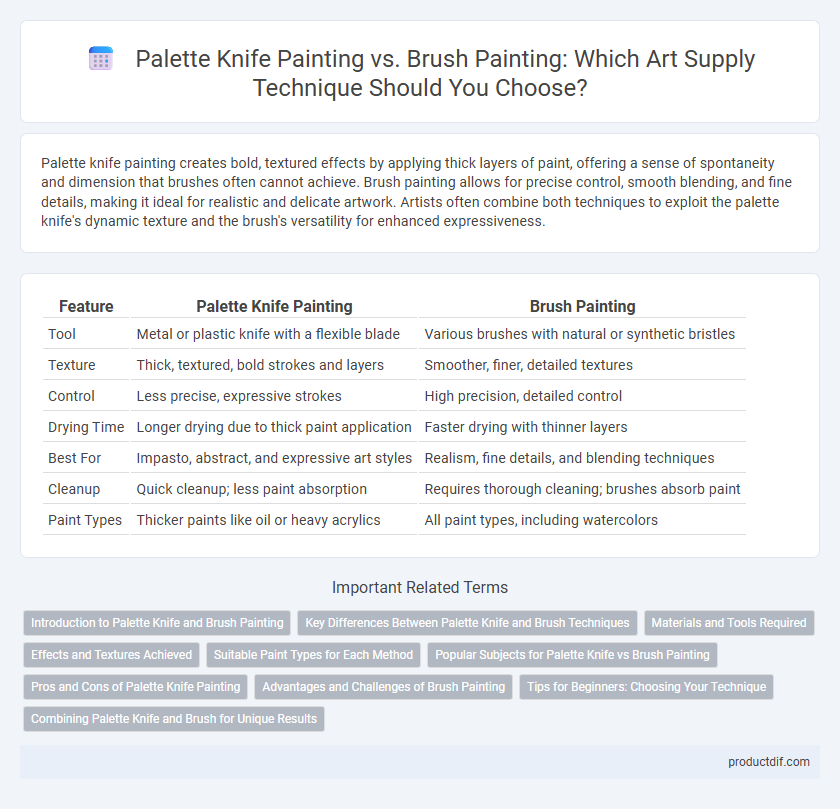Palette knife painting creates bold, textured effects by applying thick layers of paint, offering a sense of spontaneity and dimension that brushes often cannot achieve. Brush painting allows for precise control, smooth blending, and fine details, making it ideal for realistic and delicate artwork. Artists often combine both techniques to exploit the palette knife's dynamic texture and the brush's versatility for enhanced expressiveness.
Table of Comparison
| Feature | Palette Knife Painting | Brush Painting |
|---|---|---|
| Tool | Metal or plastic knife with a flexible blade | Various brushes with natural or synthetic bristles |
| Texture | Thick, textured, bold strokes and layers | Smoother, finer, detailed textures |
| Control | Less precise, expressive strokes | High precision, detailed control |
| Drying Time | Longer drying due to thick paint application | Faster drying with thinner layers |
| Best For | Impasto, abstract, and expressive art styles | Realism, fine details, and blending techniques |
| Cleanup | Quick cleanup; less paint absorption | Requires thorough cleaning; brushes absorb paint |
| Paint Types | Thicker paints like oil or heavy acrylics | All paint types, including watercolors |
Introduction to Palette Knife and Brush Painting
Palette knife painting utilizes a flat, flexible steel blade to apply thick layers of paint, creating textured, impasto effects that enhance dimensionality and dynamic movement in artworks. Brush painting employs various types and sizes of brushes made from natural or synthetic bristles to produce smooth, controlled strokes ideal for detailed blending and fine lines. Artists often choose palette knives for bold, expressive techniques and brushes for precision and subtle gradations in color and tone.
Key Differences Between Palette Knife and Brush Techniques
Palette knife painting creates bold textures and sharp edges by applying thick layers of paint, making it ideal for expressive, impasto effects. Brush painting offers precise control, allowing for smooth blending, fine details, and varied strokes critical for realism and delicate shading. The choice between palette knife and brush techniques impacts texture, detail, and overall style in art supply usage.
Materials and Tools Required
Palette knife painting requires a selection of knives with flexible, durable steel blades and comfortable handles to manipulate thick layers of oil or acrylic paint, while brush painting relies on various brushes made from synthetic or natural bristles designed for controlled strokes and fine details. Palette knives facilitate textured, impasto effects by applying and scraping paint, eliminating the need for traditional brushes, palettes, or water containers that are essential in brush painting. Both techniques demand high-quality paints, but palette knife painting often benefits from heavier body paints to maintain texture, whereas brush painting accommodates a broader range of paint viscosities for smooth blending and fine articulation.
Effects and Textures Achieved
Palette knife painting creates bold, textured effects with thick, impasto layers that emphasize surface dimension and dynamic strokes. Brush painting offers smoother, more controlled blending and fine detail, allowing for subtle gradients and delicate textures. Artists choose palette knives for expressive, tactile artwork and brushes for precision and softness in texture.
Suitable Paint Types for Each Method
Palette knife painting works best with thick, heavy-bodied paints such as oil and acrylics, allowing for textured, impasto effects that create dimension and depth on the canvas. Brush painting is versatile, suitable for a wide range of paint types including watercolors, gouache, oils, and acrylics, enabling smooth blending, detailed strokes, and varied finishes. Selecting the right paint type enhances the effectiveness of each technique, with palette knives favoring viscous media and brushes accommodating both thin and thick consistencies.
Popular Subjects for Palette Knife vs Brush Painting
Palette knife painting commonly features bold textures and expressive landscapes, capturing rugged mountains, vibrant sunsets, and rustic still lifes with thick, impasto strokes. Brush painting excels in detailed portraits, delicate florals, and smooth gradients, offering precise control for realism and fine detail. Artists often choose palette knives for abstract or dynamic scenes, while brushes suit intricate compositions requiring subtle shading and blending.
Pros and Cons of Palette Knife Painting
Palette knife painting offers unique texture and bold, expressive strokes that create a three-dimensional effect appealing to abstract and impasto art styles. It allows for thick application of paint with minimal blending, making it easier to achieve sharp edges and dynamic color contrasts, but it can be challenging to control fine details compared to brush painting. Palette knives are also durable and easy to clean, but their rigidity limits subtle gradients and delicate line work that brushes excel at.
Advantages and Challenges of Brush Painting
Brush painting offers precise control and versatility, allowing artists to create fine details and smooth gradients with various brush types and sizes. Challenges include the need for skillful handling to avoid streaks or unintended textures, and brushes require regular cleaning to maintain their shape and performance. Despite these difficulties, brush painting remains essential for achieving intricate designs and delicate color blending in artworks.
Tips for Beginners: Choosing Your Technique
Palette knife painting offers bold textures and vibrant strokes ideal for expressive artwork, while brush painting provides versatility with smooth blending and fine detail control. Beginners should consider starting with palette knives to experiment with layering and impasto effects, as they require less precise control than brushes. Selecting quality synthetic brushes or stainless steel palette knives enhances technique development and overall painting experience.
Combining Palette Knife and Brush for Unique Results
Combining palette knife and brush painting techniques enhances texture and depth, creating vibrant, multidimensional artworks. Palette knives apply thick, expressive layers of paint, while brushes allow for fine details and smooth blending, resulting in a dynamic contrast. Artists achieve unique effects by alternating these methods, enriching both the surface quality and visual interest of their pieces.
Palette Knife Painting vs Brush Painting Infographic

 productdif.com
productdif.com